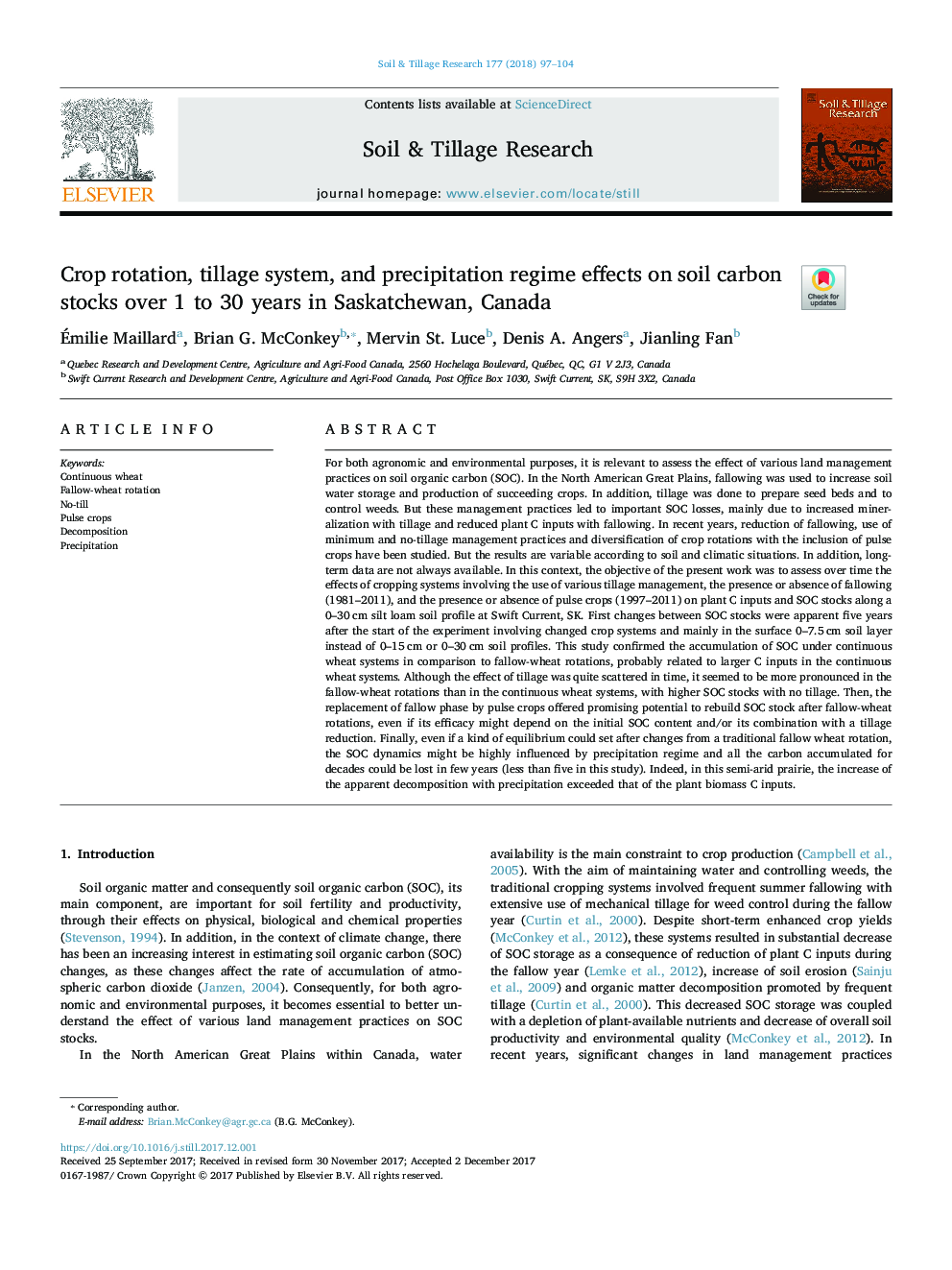| کد مقاله | کد نشریه | سال انتشار | مقاله انگلیسی | نسخه تمام متن |
|---|---|---|---|---|
| 6773199 | 1431826 | 2018 | 8 صفحه PDF | دانلود رایگان |
عنوان انگلیسی مقاله ISI
Crop rotation, tillage system, and precipitation regime effects on soil carbon stocks over 1 to 30 years in Saskatchewan, Canada
ترجمه فارسی عنوان
چرخش محصول، سیستم ریشخواری و رژیم رطوبت بر روی ذخایر کربن خام بیش از 1 تا 30 سال در ساسکاچوان، کانادا
دانلود مقاله + سفارش ترجمه
دانلود مقاله ISI انگلیسی
رایگان برای ایرانیان
کلمات کلیدی
گندم پیوسته، چرخش فلفل گندم، خیر محصولات پالس، تجزیه، بارش،
موضوعات مرتبط
مهندسی و علوم پایه
مهندسی انرژی
انرژی های تجدید پذیر، توسعه پایدار و محیط زیست
چکیده انگلیسی
For both agronomic and environmental purposes, it is relevant to assess the effect of various land management practices on soil organic carbon (SOC). In the North American Great Plains, fallowing was used to increase soil water storage and production of succeeding crops. In addition, tillage was done to prepare seed beds and to control weeds. But these management practices led to important SOC losses, mainly due to increased mineralization with tillage and reduced plant C inputs with fallowing. In recent years, reduction of fallowing, use of minimum and no-tillage management practices and diversification of crop rotations with the inclusion of pulse crops have been studied. But the results are variable according to soil and climatic situations. In addition, long-term data are not always available. In this context, the objective of the present work was to assess over time the effects of cropping systems involving the use of various tillage management, the presence or absence of fallowing (1981-2011), and the presence or absence of pulse crops (1997-2011) on plant C inputs and SOC stocks along a 0-30â¯cm silt loam soil profile at Swift Current, SK. First changes between SOC stocks were apparent five years after the start of the experiment involving changed crop systems and mainly in the surface 0-7.5â¯cm soil layer instead of 0-15â¯cm or 0-30â¯cm soil profiles. This study confirmed the accumulation of SOC under continuous wheat systems in comparison to fallow-wheat rotations, probably related to larger C inputs in the continuous wheat systems. Although the effect of tillage was quite scattered in time, it seemed to be more pronounced in the fallow-wheat rotations than in the continuous wheat systems, with higher SOC stocks with no tillage. Then, the replacement of fallow phase by pulse crops offered promising potential to rebuild SOC stock after fallow-wheat rotations, even if its efficacy might depend on the initial SOC content and/or its combination with a tillage reduction. Finally, even if a kind of equilibrium could set after changes from a traditional fallow wheat rotation, the SOC dynamics might be highly influenced by precipitation regime and all the carbon accumulated for decades could be lost in few years (less than five in this study). Indeed, in this semi-arid prairie, the increase of the apparent decomposition with precipitation exceeded that of the plant biomass C inputs.
ناشر
Database: Elsevier - ScienceDirect (ساینس دایرکت)
Journal: Soil and Tillage Research - Volume 177, April 2018, Pages 97-104
Journal: Soil and Tillage Research - Volume 177, April 2018, Pages 97-104
نویسندگان
Ãmilie Maillard, Brian G. McConkey, Mervin St. Luce, Denis A. Angers, Jianling Fan,
